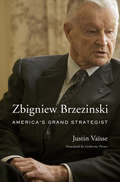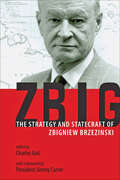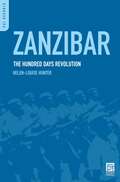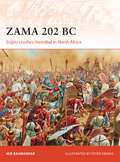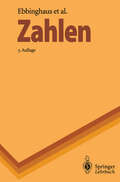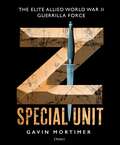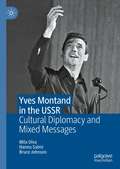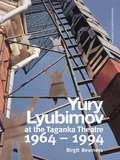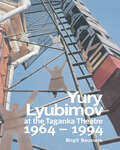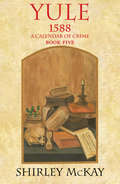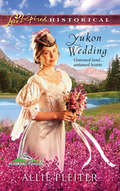- Table View
- List View
Zbigniew Brzezinski: America’s Grand Strategist
by Justin VaïsseAs National Security Adviser to President Jimmy Carter, Zbigniew Brzezinski (1928–2017) guided U.S. foreign policy at a critical juncture of the Cold War. But his impact on America’s role in the world extends far beyond his years in the White House, and reverberates to this day. His geopolitical vision, scholarly writings, frequent media appearances, and policy advice to decades of presidents from Lyndon Johnson to Barack Obama made him America’s grand strategist, a mantle only Henry Kissinger could also claim. Both men emigrated from turbulent Europe in 1938 and got their Ph.D.s in the 1950s from Harvard, then the epitome of the Cold War university. With its rise to global responsibilities, the United States needed professionals. Ambitious academics like Brzezinski soon replaced the old establishment figures who had mired the country in Vietnam, and they transformed the way America conducted foreign policy. Justin Vaïsse offers the first biography of the successful immigrant who completed a remarkable journey from his native Poland to the White House, interacting with influential world leaders from Gloria Steinem to Deng Xiaoping to John Paul II. This complex intellectual portrait reveals a man who weighed in on all major foreign policy debates since the 1950s, from his hawkish stance on the USSR to his advocacy for the Middle East peace process and his support for a U.S.-China global partnership. Through its examination of Brzezinski’s statesmanship and comprehensive vision, Zbigniew Brzezinski raises important questions about the respective roles of ideas and identity in foreign policy.
Zbigniew Brzezinski: America’s Grand Strategist
by Justin VaïsseAs National Security Adviser to President Jimmy Carter, Zbigniew Brzezinski (1928–2017) guided U.S. foreign policy at a critical juncture of the Cold War. But his impact on America’s role in the world extends far beyond his years in the White House, and reverberates to this day. His geopolitical vision, scholarly writings, frequent media appearances, and policy advice to decades of presidents from Lyndon Johnson to Barack Obama made him America’s grand strategist, a mantle only Henry Kissinger could also claim. Both men emigrated from turbulent Europe in 1938 and got their Ph.D.s in the 1950s from Harvard, then the epitome of the Cold War university. With its rise to global responsibilities, the United States needed professionals. Ambitious academics like Brzezinski soon replaced the old establishment figures who had mired the country in Vietnam, and they transformed the way America conducted foreign policy. Justin Vaïsse offers the first biography of the successful immigrant who completed a remarkable journey from his native Poland to the White House, interacting with influential world leaders from Gloria Steinem to Deng Xiaoping to John Paul II. This complex intellectual portrait reveals a man who weighed in on all major foreign policy debates since the 1950s, from his hawkish stance on the USSR to his advocacy for the Middle East peace process and his support for a U.S.-China global partnership. Through its examination of Brzezinski’s statesmanship and comprehensive vision, Zbigniew Brzezinski raises important questions about the respective roles of ideas and identity in foreign policy.
Zbig: The Strategy and Statecraft of Zbigniew Brzezinski
by Jimmy Carter Charles GatiZbigniew Brzezinski’s multifaceted career dealing with U.S. security and foreign policy has led him from the halls of academia to multiple terms in public service, including a stint as President Jimmy Carter’s National Security Advisor from 1977 to 1981. He is a renowned policy analyst and author who frequently appears as a commentator on popular talk shows, and his strategic vision continues to carry a great deal of gravitas. in Zbig, Charles Gati has enlisted many of the top foreign policy players of the past thirty years to reflect on and analyze Brzezinski and his work. A senior scholar in Eastern European and Russian studies, Gati observed firsthand much of the history and politics surrounding Brzezinski’s career. His vibrant introduction and concluding interview with Brzezinski frame this critical assessment of a major statesman’s accomplishments.Contributors: Justin Vaïsse, David C. Engerman, Mark Kramer, David J. Rothkopf, Warren I. Cohen and Nancy Bernkopf Tucker, Robert A. Pastor, William B. Quandt, Robert Hunter, James Thomson, Patrick Vaughan, Marin Strmecki, James Mann, David Ignatius, Adam Garfinkle, Stephen F. Szabo, Francis Fukuyama, Charles Gati
Zanzibar: The Hundred Days Revolution (PSI Reports)
by Helen-Louise HunterIn the late 1950s, Communists decided that Zanzibar offered them a particular favorable opportunity for expanding their influence.
Zanzibar: Background to Revolution
by Michael F. LofchieThis book gives a detailed analysis of the causes of the revolution of January 1964 in Zanzibar, and provides a study of the process of modernization in a plural society.Originally published in 1965.The Princeton Legacy Library uses the latest print-on-demand technology to again make available previously out-of-print books from the distinguished backlist of Princeton University Press. These editions preserve the original texts of these important books while presenting them in durable paperback and hardcover editions. The goal of the Princeton Legacy Library is to vastly increase access to the rich scholarly heritage found in the thousands of books published by Princeton University Press since its founding in 1905.
Zambia: The First 50 Years (International Library of African Studies)
by Andrew SardanisOn 24 October 1964, the Republic of Zambia was formed, replacing the territory which had formerly been known as Northern Rhodesia. Fifty years on, Andrew Sardanis provides a sympathetic but critical insider's account of Zambia, from independence to the present. He paints a stark picture of Northern Rhodesia at decolonisation and the problems of the incoming government, presented with an immense uphill task of rebuilding the infrastructure of government and administration – civil service, law, local government and economic development. Sardanis was a minister at the heart of the government and later a highly successful entrepreneur. As a friend and colleague of many of the most prominent names in post-independence Zambia – from the presidencies of founding leader Kenneth Kaunda to the incumbent Michael Sata – he uses his unique eyewitness experience to provide an inside view of a country in transition. He looks at the highs and lows of Zambia's political development: a purposeful beginning followed by many blunders; confusion, at times bordering on chaos, interspersed with flashes of sensible action and good work. This book provides a detailed examination of the major events in Zambia's history since independence and their effect on the country's development and progress, based on Sardanis's in-depth knowledge of Zambia and its people and the inner workings of its government.
Zambesi: David Livingstone and Expeditionary Science in Africa (Tauris Historical Geographical Series)
by Lawrence DritsasIn March 1858 David Livingstone's Zambesi Expedition left Liverpool for Africa. It would not return until July 1864. In the two years leading up to this moment, Livingstone had been transformed from a lone apostle of the London Missionary Society into a national hero and icon of Victorian manhood. Addressing the crowds that had gathered to bid him Godspeed, he declared his intentions to be to put an end to slavery by introducing alternative commerce to south-central Africa: 'What I want to do is get in the thin edge of the wedge, and then leave it to be driven home by English energy and English spirit.'Livingstone had planned the expedition several years earlier as he toured the country speaking to large audiences about the evils of the slave trade. Publicly and privately he promoted his vision of British industry, British commerce and Christianity working together to bring the light of civilisation to a dark continent. The Zambesis Expedition would gather the information that would allow Livingstone's grand scheme to move forward. But the truth was that there was little commercial interest in this part of Africa and, while the civilising mission ideology worked as a powerful rhetoric for the philanthropically minded mid-Victorians, by the time of the expedition the official mind was moving against such notions: it was only Livingstone's fame combined with lobbying from establishment leaders who pursued a scientific agenda for the project, that the expedition came into existence.Zambesi is a tale of expeditionary science in the raw. It exposes the rivalry among some of Victorian Britain's leading establishment figures and institutions - including the Foreign Office, theAdmiralty, the Royal Society, Royal Geographical Society,Kew Gardens and the British Museum - as abolitionists, scientists, and entrepreneurs sought to promote and protect their differing interests. Making use of letters, documents and materials negelcted by previous writers and researchers, the author reveals how tensions arose from the very beginning between those in pursuit of knowledge for its own sake and the proponents of the civilising missions who saw scientific knowledge as the utilitarian means to a social end. The result is a compelling account involving one of Victorian England's most feted heroes that offers important new insights in the the practice of expeditionary science in Victorian England.The most complete account of the Zambesi expedition yet published, Zambesi: David Livingstone and Expeditionary Science in Africa will be essential reading for historical geographers and historians of science and empire, and for all those with an interest in Africa, Victorian studies, travel and exploration and the work and life of David Livingstone.
Zama 202 BC: Scipio crushes Hannibal in North Africa (Campaign)
by Peter Dennis Mir BahmanyarThe battle of Zama, fought across North Africa around 202 BC, was the final large-scale clash of arms between the world's two greatest western powers of the time – Carthage and Rome. The engagement ended the Second Punic War, waged from 218 until 201 BC. The armies were led by two of the most famous commanders of all time – the legendary Carthaginian general Hannibal, renowned for crossing the Alps with his army into Italy, and the Roman general Publius Cornelius Scipio, who along with his father was among the defeated at the battle of Cannae in 216 BC.Drawing upon years of research, author Mir Bahmanyar gives a detailed account of this closing battle, analysing the tactics employed by each general and the forces they had at their disposal. Stunning, specially commissioned artwork brings to life the epic clash that saw Hannibal defeated and Rome claim its spot as the principal Mediterranean power.
Zama 202 BC: Scipio crushes Hannibal in North Africa (Campaign)
by Peter Dennis Mir BahmanyarThe battle of Zama, fought across North Africa around 202 BC, was the final large-scale clash of arms between the world's two greatest western powers of the time – Carthage and Rome. The engagement ended the Second Punic War, waged from 218 until 201 BC. The armies were led by two of the most famous commanders of all time – the legendary Carthaginian general Hannibal, renowned for crossing the Alps with his army into Italy, and the Roman general Publius Cornelius Scipio, who along with his father was among the defeated at the battle of Cannae in 216 BC.Drawing upon years of research, author Mir Bahmanyar gives a detailed account of this closing battle, analysing the tactics employed by each general and the forces they had at their disposal. Stunning, specially commissioned artwork brings to life the epic clash that saw Hannibal defeated and Rome claim its spot as the principal Mediterranean power.
Zainichi Cinema: Korean-in-Japan Film Culture
by Oliver DewThis book examines how filmmakers, curators, and critics created a category of transnational, Korean-in-Japan (Zainichi) Cinema, focussing on the period from the 1960s onwards. An enormously diverse swathe of films have been claimed for this cinema of the Korean diaspora, ranging across major studio yakuza films and melodramas, news reels created by ethnic associations, first-person video essays, and unlikely hits that crossed over from the indie distribution circuit to have a wide impact across the media landscape. Today, Zainichi-themed works have never had a higher profile, with new works by Matsue Tetsuaki, Sai Yoichi, and Yang Yonghi frequently shown at international festivals. Zainichi Cinema argues that central to this transnational cinema is the tension between films with an authorized claim to “represent”, and ambiguous and borderline works that require an active spectator to claim them as images of the Korean diaspora.
Zahlen (Springer-Lehrbuch)
by Heinz-Dieter Ebbinghaus Hans Hermes Friedrich Hirzebruch Max Koecher Klaus Mainzer Jürgen Neukirch Alexander Prestel Reinhold RemmertMathematik zu erlernen und zu lehren gilt als schwierig. Die Begriffe reelle und komplexe Zahlen oder die Kreiszahl Pi sind zwar vielen bekannt, aber nur wenige wissen, was dahinter steckt. Leser, die erfahren wollen, was sich wirklich dahinter verbirgt, werden in diesem Band an die Magie der Mathematik herangeführt: „Das Lesen ist ein Genuß, den man sich nicht entgehen lassen sollte." (Jahresbericht der Deutschen Mathematiker-Vereinigung).
Zadruga
by Margaret PembertonIn the stormy turmoil of old Sarajevo, their passionate story began . . . In Belgrade, in the balmy spring of 1914, neither of the royally related Karageorgevich sisters had the slightest presentiment of disaster. Seventeen-year-old Natalie was enjoying the danger and secrecy of friendship with young nationalists, eager to free their lands from Habsburg domination. Katerina, her less volatile sister, was deeply and secretly in love with Julian Fielding, a young English diplomat. Then, when accompanying their father on an official visit to Sarajevo, Natalie inadvertently plunged their lives into chaos as she found herself caught up in the assassination of Archduke Franz Ferdinand, heir to the Austrian Empire. As the Austrians demanded her extradition Natalie had no choice but to flee the homeland she so passionately loved. She chose to leave in a manner that was to prove catastrophic – as the bride of Julian Fielding, the man her sister loved.
Zachary Black: Duke Of Debauchery (Dangerous Dukes #1)
by Carole MortimerLONDON’S MOST DISSOLUTE BACHELOR
Z Special Unit: The Elite Allied World War II Guerrilla Force
by Gavin MortimerLeading expert Gavin Mortimer tells the remarkable origin story of a wartime special forces unit that defied the odds.Z Special Unit, one of the most intrepid but arguably the most unsung of Allied Special Forces of the Second World War waged a guerrilla war against Japan for two years in the south-west Pacific. On some of their 81 operations Z Special Unit slipped into enemy harbours in canoes and silently mined ships before vanishing into the night; on others they parachuted into the dense Borneo jungle to fight with headhunters against the Japanese and on one occasion they landed on an Indonesian island and smuggled out the pro-Allied sultan from under Japanese noses. The Japanese weren't the only adversary that Z Special Unit encountered in the brutal terrain of the Pacific. In the mango swamps of Borneo and the dense jungle of Papua New Guinea they were faced with venomous snakes, man-eating crocodiles and deadly diseases. But it was the enemy soldiers who proved the most ruthless foe, beheading those Z Special Unit commandos who fell into their hands.Drawing on veteran interviews as well as operational reports and recently declassified SOE files, Gavin Mortimer explores the incredible history of this remarkable special forces unit and the band of commandoes that defied the odds.
Z Special Unit: The Elite Allied World War II Guerrilla Force
by Gavin MortimerLeading expert Gavin Mortimer tells the remarkable origin story of a wartime special forces unit that defied the odds.Z Special Unit, one of the most intrepid but arguably the most unsung of Allied Special Forces of the Second World War waged a guerrilla war against Japan for two years in the south-west Pacific. On some of their 81 operations Z Special Unit slipped into enemy harbours in canoes and silently mined ships before vanishing into the night; on others they parachuted into the dense Borneo jungle to fight with headhunters against the Japanese and on one occasion they landed on an Indonesian island and smuggled out the pro-Allied sultan from under Japanese noses. The Japanese weren't the only adversary that Z Special Unit encountered in the brutal terrain of the Pacific. In the mango swamps of Borneo and the dense jungle of Papua New Guinea they were faced with venomous snakes, man-eating crocodiles and deadly diseases. But it was the enemy soldiers who proved the most ruthless foe, beheading those Z Special Unit commandos who fell into their hands.Drawing on veteran interviews as well as operational reports and recently declassified SOE files, Gavin Mortimer explores the incredible history of this remarkable special forces unit and the band of commandoes that defied the odds.
Z: The inspiration behind the Amazon Original show Z THE BEGINNING OF EVERYTHING starring Christina Ricci as Zelda
by Therese Anne FowlerTHE NEW YORK TIMES BESTSELLER & AMAZON ORIGINALS TV SERIES STARRING CHRISTINA RICCI - Z: THE BEGINNING OF EVERYTHING'If ever a couple ... became an era, it was F Scott Fitzgerald and his glamorous "flapper" wife, Zelda. They were the Jazz Age.' - Independent When beautiful, reckless Southern belle Zelda Sayre meets F. Scott Fitzgerald at a country club dance in 1918, she is seventeen and he is a young army lieutenant. Before long, Zelda has fallen for him, even though Scott isn't wealthy or prominent or even a Southerner and keeps insisting, absurdly, that his writing will bring him both fortune and fame. When he sells his first novel, she optimistically boards a train to New York, to marry him and take the rest as it comes.What comes, here at the dawn of the Jazz Age, is unimagined success and celebrity that will make Scott and Zelda legends in their own time. Each place they go becomes a playground:New York City, Long Island, Hollywood, Paris, and the French Riviera - where they join the endless party of the glamorous, sometimes doomed Lost Generation that includes Ernest Hemingway, Sara and Gerald Murphy, and Gertrude Stein.Everything seems new and possible, but not even Jay Gatsby's parties go on forever. Who is Zelda, other than the wife of a famous - sometimes infamous - husband? With brilliant insight and imagination, Therese Anne Fowler brings us Zelda's irresistible story as she herself might have told it.'Utterly compulsive reading' Stylist'Brilliant' Daily Mail'Superb' Independent***THERESE ANNE FOWLER'S NEW NOVEL, A WELL-BEHAVED WOMAN: A NOVEL OF THE VANDERBILTS, IS OUT NOW***
Yves Montand in the USSR: Cultural Diplomacy and Mixed Messages
by Mila Oiva Hannu Salmi Bruce JohnsonThis volume is the first book-length account of Yves Montand’s controversial tour of the Soviet Union at the turn of the years 1956/57. It traces the mixed messages of this internationally visible act of cultural diplomacy in the middle of the turbulent Cold War. It also provides an account of the celebrated French singer-actor’s controversial career, his dedication to music and to peace activism, as well as his widespread fandom in the USSR. The book describes the political background for the events of the year 1956, including the changing Soviet atmosphere after Stalin’s death, portrays the rising transnational stardom of Montand in the 1940s and 1950s, and explores the controversies aroused by his plan to visit Moscow after the Hungarian Uprising. The book pays particular attention to Montand’s reception in the USSR and his concert performances, drawing on unique archival material and oral history interviews, and analyses the documentary Yves Montand Sings (1957) released immediately after his visit.
Yves de Vallone: The Making of an Esprit-Fort (International Archives of the History of Ideas Archives internationales d'histoire des idées #97)
by James O'HigginsThe writing of the second part of this book presented a peculiar difficulty. On the one hand I had the great advantage of having found the first rough draft of the manuscript La Religion du Chretien, corrected and often recorrected. Authorship could eventually be established beyond shadow of doubt, and in the corrections one could see de Vallone changing his opinions as he wrote. On the other the sheer length of the manuscript - about 140,000 words - plus the num ber of corrections - well over 3,000, many of them lengthy - the enormous number of references in the text to the Classics, to the Scriptures and Apochrypha, to the Fathers, to Philosophers, ancient and contemporary or near contemporary to de Vallone, and to a considerable number of other contem porary authors, all of which would require a footnote (not to speak of other footnotes necessary as comments on the text itself) made the production of a critical edition a financial impossibility. Instead I decided, for the sake of scholars interested in this type of manuscript, to give a full, i. ndeed meticulous perhaps too meticulous - digest of the manuscript with a running commentary, showing the influences working on de Vallone, the intellectual atmosphere in which he lived, indicating the significance of all the major revisions and correc tions in his text and commenting on what one can only describe as his own world-theory and on his use of his authorities and of their influence upon him.
Yuri Lyubimov: Thirty Years at the Taganka Theatre
by B. BeumersA study of Yury Lyubimov's tempestuous career and his style of theatre during his thirty years at the Taganka Theatre. This work traces the development of his ideas, from his arrival at the theatre in 1964 through to his explusion in 1984, and his period of exile in the West until his return in 1989 to a much-changed Russia. Tracing Lyubimov's work play by play, the book uncovers an individual doomed to be at odds with the prevailing political and social climate of his literary contemporaries.
Yuri Lyubimov: Thirty Years at the Taganka Theatre
by B. BeumersA study of Yury Lyubimov's tempestuous career and his style of theatre during his thirty years at the Taganka Theatre. This work traces the development of his ideas, from his arrival at the theatre in 1964 through to his explusion in 1984, and his period of exile in the West until his return in 1989 to a much-changed Russia. Tracing Lyubimov's work play by play, the book uncovers an individual doomed to be at odds with the prevailing political and social climate of his literary contemporaries.
Yunnan–Burma–Bengal Corridor Geographies: Protean Edging of Habitats and Empires
by Dan Smyer Yü Karin DeanThis book explores the historical interconnections between Bengal, Burma, and Yunnan (China), and views the corridor as a transregion that exhibits mobility, connectivity and diversity as well as place-based ecogeological uniqueness. With a focus on the concept of corridor geographies that have shared human and environmental histories beyond sharply demarcated territorial sovereignties of modern individual nation-states, it presents the variety and complexity of premodern and modern pathways, corridors, borders, and networks of livelihood-making, local political alliances, trade and commerce, religions, political systems, and colonial encounters. The book discusses crucial themes including environmental edgings of human-nonhuman habitats, transregional migratory routes and habitats of megafauna, elephant corridors in Yunnan–Myanmar–Bengal landscape, framing spaces between India and China, Tibetan–Myanmar corridors, transboundary river systems, narratives of a Rohingya jade trader, cross-border flow of De’ang’s fermented tea, householding in upland Laos, cultural identities, and trans-border livelihoods. Comprehensive and topical, with its wide-ranging case studies, this book will be of interest to scholars and researchers of history, routes and border studies, sociology and social anthropology, South East Asian history, South Asian history, Chinese studies, environmental history, human geography, international relations, ecology, and cultural studies.
Yunnan–Burma–Bengal Corridor Geographies: Protean Edging of Habitats and Empires
by Dan Smyer Yü Karin DeanThis book explores the historical interconnections between Bengal, Burma, and Yunnan (China), and views the corridor as a transregion that exhibits mobility, connectivity and diversity as well as place-based ecogeological uniqueness. With a focus on the concept of corridor geographies that have shared human and environmental histories beyond sharply demarcated territorial sovereignties of modern individual nation-states, it presents the variety and complexity of premodern and modern pathways, corridors, borders, and networks of livelihood-making, local political alliances, trade and commerce, religions, political systems, and colonial encounters. The book discusses crucial themes including environmental edgings of human-nonhuman habitats, transregional migratory routes and habitats of megafauna, elephant corridors in Yunnan–Myanmar–Bengal landscape, framing spaces between India and China, Tibetan–Myanmar corridors, transboundary river systems, narratives of a Rohingya jade trader, cross-border flow of De’ang’s fermented tea, householding in upland Laos, cultural identities, and trans-border livelihoods. Comprehensive and topical, with its wide-ranging case studies, this book will be of interest to scholars and researchers of history, routes and border studies, sociology and social anthropology, South East Asian history, South Asian history, Chinese studies, environmental history, human geography, international relations, ecology, and cultural studies.
Yule (1588: A Calendar of Crime)
by Shirley McKayYule is the fifth instalment of 1588: A Calendar of Crime, a collection of short stories published in step with the sixteenth century calendar.Despite prohibitions on celebrating Yule, the old traditions still persist among the tenant farmers on Hew’s estate at Kenly Green. Hew defends a tenant against both Kirk and Crown when a violent accident befalls an unwelcome guest who has turned up uninvited to the feast.
Yukon Wedding (Alaskan Brides #1)
by Allie PleiterA gold-rush town is no place for a single mother. But widow Lana Bristow won't abandon the only home her son has ever known. She'll fight to remain in Treasure Creek, Alaska–even if it means wedding Mack Tanner, the man she blames for her husband's death.

